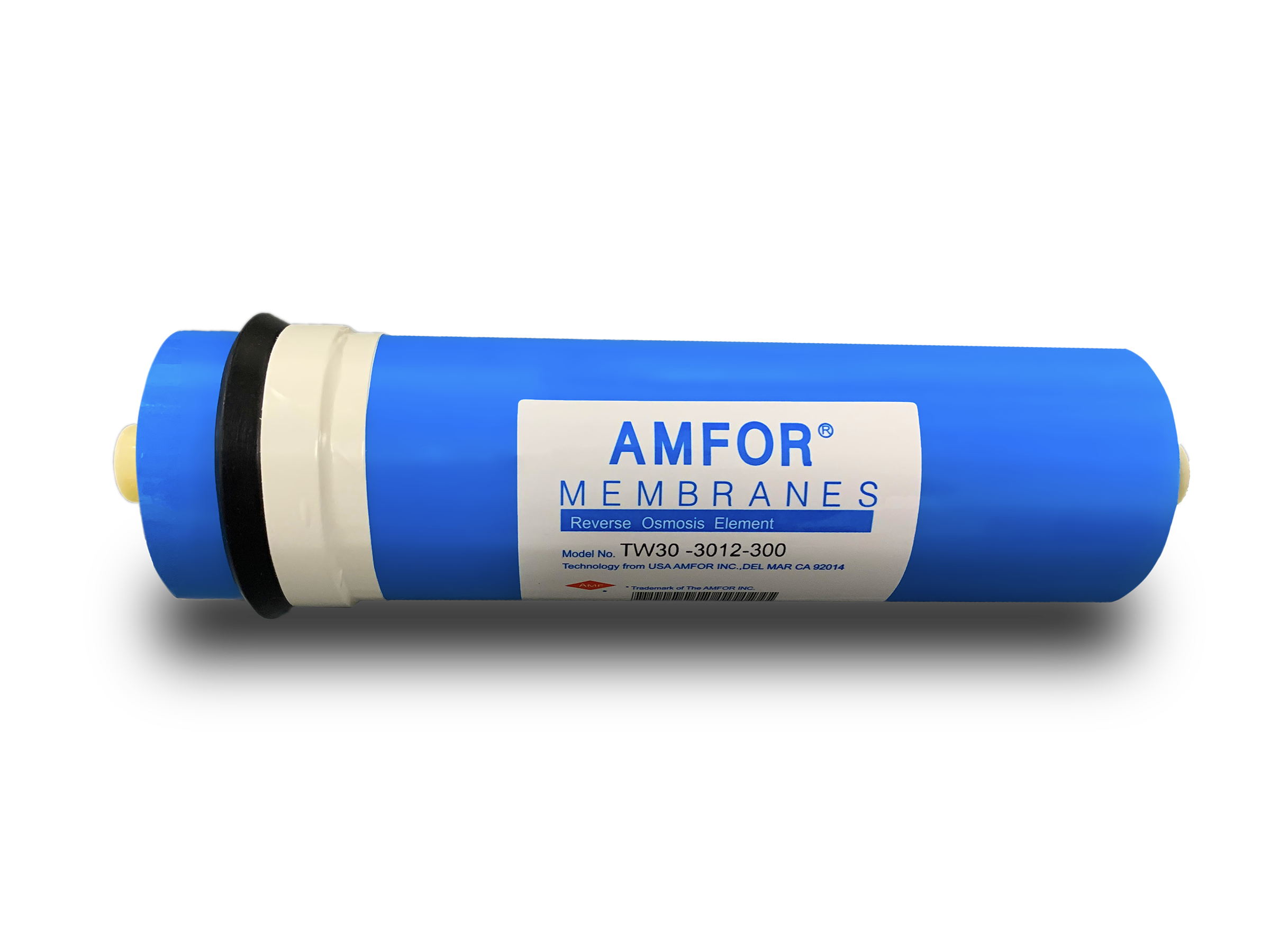Residential RO Membrane

Residential RO Membrane
What’s Reverse Osmosis?
Reverse osmosis is a filtration process that is often used for water. It works by using pressure to force a solution through a membrane, retaining the solute on one side and allowing the pure solvent to pass to the other side. This is the reverse of the normal osmosis process, which is the natural movement of solvent from an area of low solute concentration, through a membrane, to an area of high solute concentration when no external pressure is applied.
AMFOR® reverse osmosis membrane elements for home drinking water are the most reliable. Advanced membrane technology and automated fabrication allow these elements to keep consistent performance and suitable for long distance transportation. AMFOR home drinking water elements are rated at 50psi and will purify about 20% more water than competitive elements rated at 60psi (please see the datasheet for more information)
Product specifications
| Product | Product (gpd) | Water (m3/d) | Flow Rate (lph) | Minimum Salt Rejection Cl-(%) | Stabilized Salt Rejection Cl- (%) |
| TW30-1812-24 | 24 | 0.09 | 3.8 | 96 | 98 |
| TW30-1812-36 | 36 | 0.14 | 5.7 | 96 | 98 |
| TW30-1812-50 | 50 | 0.19 | 7.9 | 96 | 98 |
| TW30-1812-75 | 75 | 0.28 | 12.0 | 96 | 98 |
| TW30-2012-100 | 100 | 0.38 | 15.8 | 96 | 98 |
| TW30-2812-150 | 150 | 0.57 | 23.7 | 96 | 98 |
| TW30-2812-200 | 200 | 0.76 | 31.6 | 96 | 98 |
| TW30-3012-300 | 300 | 1.14 | 47.4 | 96 | 98 |
| TW30-1810(Disposable element) | 50-150 | 0.19-0.57 | 7.9-23.7 | 90-96 | 90-98 |
* Permeate flow and salt rejection based on the fol owing test conditions: 250ppm softened tapwater, 77。F(25℃), PH=8, and 15% recovery and the specified pressure at 50psi.
* Permeate flow rates for individual elements many vary +/-20%.
* For more information, please consult with AMFOR .
Dimensions-Inches(mm)
| Product | A | B | C | D | E |
| TW30-1812-24 | 11.74(298) | 0.87(22) | 0.68(17) | 1.75(44.5) | 10.35(263) |
| TW30-1812-36 | 11.74(298) | 0.87(22) | 0.68(17) | 1.75(44.5) | 10.35(263) |
| TW30-1812-50 | 11.74(298) | 0.87(22) | 0.68(17) | 1.75(44.5) | 10.35(263) |
| TW30-1812-75 | 11.74(298) | 0.87(22) | 0.68(17) | 1.75(44.5) | 10.35(263) |
| TW30-2012-100 | 11.74(298) | 0.87(22) | 0.68(17) | 1.75(44.5) | 10.35(263) |
| TW30-2012-150 | 11.74(298) | 0.87(22) | 0.68(17) | 1.75(44.5) | 10.35(263) |
| TW30-2812-200 | 11.74(298) | 0.87(22) | 0.68(17) | 3.00(76.2) | 10.00(254) |
| TW30-3012-300 | 11.57(294) | 0.87(22) | 0.84(21.3) | 3.00(76.2) | 10.00(254) |
| TW30-1810(Disposable element) | 10.00(254) | 0.87(22) | 0.67(17) | 1.75(44.5) | 8.5(216) |
Operating Limits
Membrane Type ..................................................................................................................................... Polyamide Thin-Film Composite
Maximum Operating Pressure ........................................................................................................................................... 300psi (21bar)
Maximum Feed Rate ..................................................................................................................................................... 2.0gpm (7.6 lpm)
Minimum Concentrate Flow Rate ................................................................................................................................ 4 × permeate flow
pH Range Continuous Operationa .................................................................................................................................................... 2-11
pH Range, Short-Term Cleaning(30min)b.......................................................................................................................................... 1-12
Maximum Operating Temperature .................................................................................................................................... 113℉ (45℃)
Maximum Feed water Turbidity .................................................................................................................................................... 1 NTU
Maximum Feed Silt Density Index ........................................................................................................................................................ 5
Free Chlorine Tolerancec.......................................................................................................................................................... <0.1ppm
a Maximum temperature for continuous operation above pH 10 is 95 (35℃).
b Refer to Cleaning Guidelines of ANDE-AMF.
c Under certain conditions, the presence of free chlorine and other oxidizing agents will cause premature membrane failure. Since oxidation damage is not covered under warranty, AMFOR recommends removing residual free chlorine by pretreatment prior to membrane exposure. Please refer to technical bulletin ANDE-AMF for more information.

